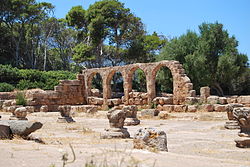Tipasa
|
تيبازة ⵜⵉⵒⴰⵣⴰ Tipasa |
||
|---|---|---|
|
|
||
| Coordinates | 36 ° 35 ' N , 2 ° 27' E | |
| Basic data | ||
| Country | Algeria | |
| ISO 3166-2 | Double room | |
| Residents | 8049 (2007) | |
Tipasa ( Arabic تيبازة, DMG Tībāza , tamazight ⵜⵉⵒⴰⵣⴰ Tipaza ; also Tibaza , formerly Tefessedt , Chenoua: Bazaar ) is a city on the Algerian coast, with 8049 inhabitants (as of 1 January 2007). It is the capital of the province of the same name and is located around 50 kilometers west of Algiers . The modern city, founded in 1857, is mainly known for its beautiful location and sandy coast.
history
Tipasa was founded by the Phoenicians and became a Roman military colony by the Romans under Emperor Claudius , later it became a municipium . The city was a stronghold of the Mauritanian fleet ( Classis mauretanica ) and economically of considerable importance.
The Christianity was introduced early in the 3rd century Tipasa bishopric was. However, most of the residents were still not Christians until - according to legend - in the 4th century St. Salsa, a Christian girl, threw the head of her snake idol into the sea, whereupon the angry population stoned her. Her body, miraculously returned from the sea, was buried on the hill above the harbor in a small chapel that was later replaced by the basilica.
In 484 the Vandal King Hunerich sent an Arian bishop to Tipasa; then a large part of the residents fled to Spain , many of those who remained were cruelly persecuted.
After that, the city disappears from history, and the later predominant Arabs do not seem to have settled here. In 1857 the modern city of Tipasa was founded.
Attractions
| Tipasa | |
|---|---|
|
UNESCO world heritage |
|

|
|
| Roman ruins |
|
| National territory: |
|
| Type: | Culture |
| Criteria : | (iii) (iv) |
| Surface: | 52.16 ha |
| Reference No .: | 193 |
| UNESCO region : | Arabic states |
| History of enrollment | |
| Enrollment: | 1982 ( session 6 ) |
| Red list : | 2002-2006 |
Are located in the Tipasa UNESCO - World Heritage counting ruins of the Roman city of Tipasa. This was built on three hills overlooking the sea. Most of the houses stood on the middle hill and are no longer preserved. However, there are ruins of three churches:
The Great Basilica and the Basilica of Alexander on the western hill and the Basilica of St. Salsa on the eastern hill.
Furthermore, two cemeteries, the baths, the theater, are the amphitheater and the Nymphaeum received. The course of the city walls can be clearly seen and at the foot of the eastern hill are the remains of the ancient port.
The basilicas are surrounded by cemeteries full of numerous stone coffins decorated with mosaics.
The basilica of St. Salsa, excavated by Stéphane Gsell , consisted of a nave with two axes, a mosaic is also preserved here.
The Great Basilica served as a “quarry” for centuries, but the seven-axis construction plan can still be recognized. There are tombs carved out of the rock under the foundation of the church; one of them is circular with a diameter of 18 meters and offered space for 24 coffins.
Others
Another city, called Tipasa in Roman times , is located 88 kilometers south of Annaba 957 meters above sea level, today this city is called Tifesh . There are ruins of a large fortress with walls up to three meters thick.
In the vicinity of Tipasa, at 36 ° 33'58 "north latitude and 2 ° 28'50" east longitude, there is a long-wave transmitter for the Algerian radio, which broadcasts a French-language program on the frequency 252 kHz in the direction of France. This station is often easy to receive in the evenings in Germany.
Albert Camus set the city a literary monument in his essays The Wedding of Light ( Noces , 1938) and Returning to Tipasa ( L'Été , 1954).




